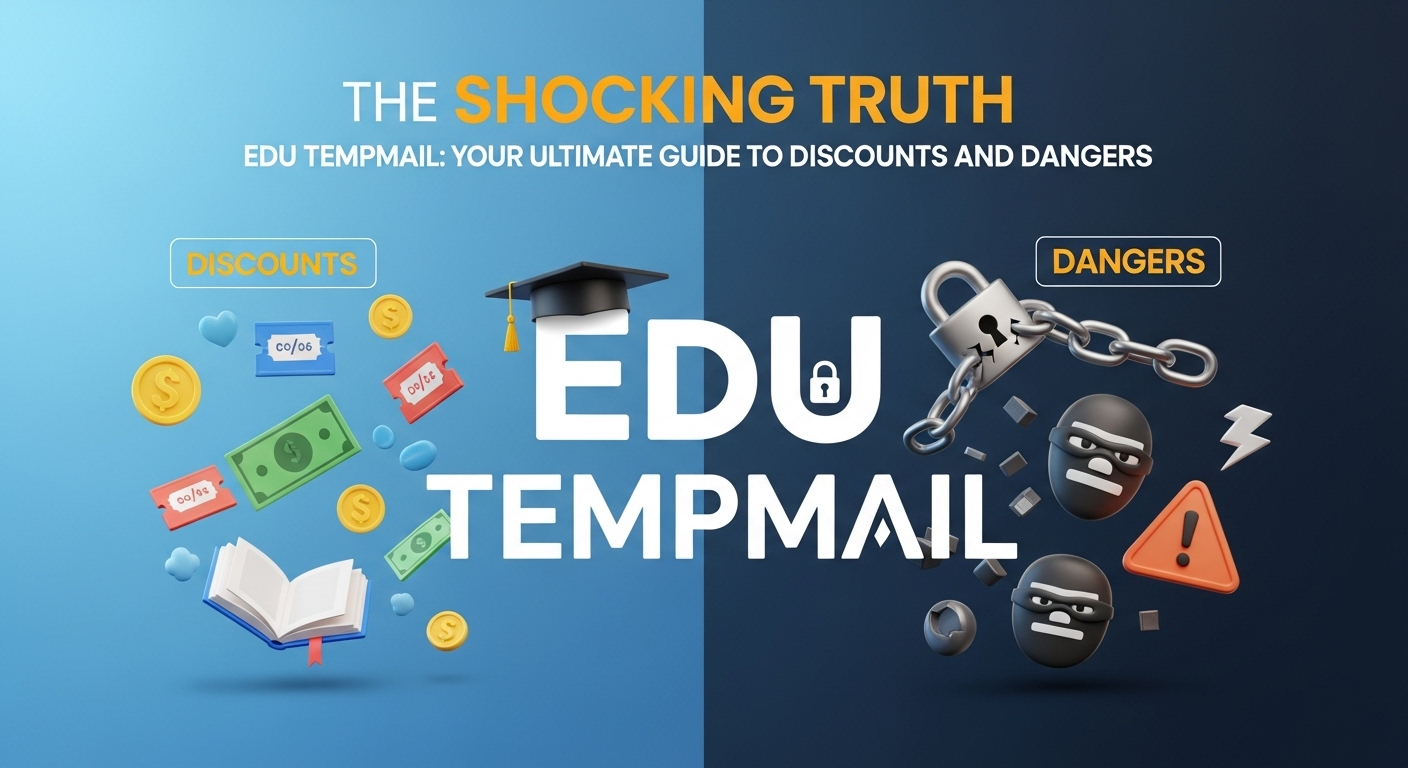Your Digital Shield: The Astonishing Truth About How Temp Mail Works

Opening your email inbox can feel like walking into a battlefield. You’re constantly dodging a barrage of promotional junk, suspicious-looking newsletters, and outright spam. It’s more than just an annoyance; it’s a genuine threat to your digital privacy and security.
Consider the sheer scale of the problem. By 2025, the world is projected to send and receive over 376.4 billion emails every single day. Hidden within that staggering number is a constant stream of danger. An estimated 3.4 billion of those daily emails are malicious phishing attempts designed to steal your information. This isn't just a hypothetical risk; it's a statistical certainty that your inbox is a target. This constant digital bombardment is a direct consequence of how we use the internet. Every time you sign up for a service, download a free guide, or make a one-time purchase, you hand over a key to your digital life: your primary email address.
This guide will do more than just tell you what a temp mail is. We will pull back the curtain and give you the definitive answer to how does tempmail work. We’ll break down the technology in plain English, reveal its incredible benefits, warn you of the hidden dangers, and empower you to use it like a privacy pro.
What is Temp Mail?
At its core, temp mail is a free, disposable email address that you can create instantly, use for a short period, and then abandon without a trace. It’s an inbox that is designed to be temporary. It exists for one purpose: to receive emails for a limited time before it self-destructs, taking all the messages it received with it.
You’ve likely heard it called by many different names, but they all point to the same brilliant concept. Understanding the jargon is the first step to mastering the tool.
- Disposable Email: This name perfectly captures its main feature. It’s an email address that is meant to be used and then thrown away, just like a disposable cup.
- Burner Email: A popular term borrowed from "burner phones," it highlights the idea of using the email for a specific, often anonymous, task and then "burning" or discarding it to sever any connection.
- Throwaway Email: This is another common phrase that simply means it’s intended for one-time use before you throw it away.
- 10 Minute Mail: This name comes from some of the earliest and most popular services, where the email address would famously expire in just 10 minutes.
- Fake Mail / Anonymous Email: These terms focus on the privacy benefit. Since the email isn't linked to your real identity, it allows you to interact online with a layer of anonymity.
How Does Temp Mail Work? The Simple 4-Step Guide for Anyone
You don't need to be a tech wizard to use a temporary email. The entire process is designed to be incredibly simple and fast. In fact, you can have a working inbox in less time than it takes to read this paragraph. Here’s how temp mail works from a user's perspective, broken down into four easy steps.
Step 1: Visit a Temp Mail Provider
First, open your web browser and navigate to a temporary email service. There are many great options, such as(https://temptomail.o) or Guerrilla Mail. The magic of these services is that there is no sign-up process. You don't need to create a password, provide your real name, or give them another email address. The moment the page loads, the service is ready to go.
Step 2: Instantly Get and Copy Your New Address
As soon as you arrive on the site, a brand-new, randomly generated email address will be displayed prominently on the screen. It will look something like x7y3bza9@someservice.com. Next to the address, you will almost always find a "Copy" button. Click it, and the address is instantly saved to your clipboard, ready to be used.
Step 3: Use the Address for Sign-ups and Verifications
Now, go to the website where you need to enter an email address. This could be a form to download an ebook, a registration page for a new service, or a checkout page for a one-time purchase. Instead of typing in your real email, simply paste the temporary address you just copied.
Step 4: Check for Emails on the Provider's Site
Return to the tab with the temp mail website. The inbox for your new address is displayed directly on that page. Within seconds, any emails sent to your temporary address—like a verification link or a confirmation code—will appear there. You can click to open the message, get the information you need, and complete your registration. Once you are done, you can simply close the browser tab. The temporary address and all of its messages will be automatically and permanently deleted after a set period of time.
To see this process in action, check out this helpful video guide:
(https://www.youtube.com/watch?v=ugTm8cBmhQU)
The Unbeatable Benefits: Why You Need a Disposable Email Today
Understanding how tempmail works is one thing, but appreciating why it's such an essential tool is another. In today's digital landscape, using a disposable email address is no longer a niche trick for tech experts; it's a fundamental practice for anyone who values their privacy and sanity. Here are the unbeatable benefits.
1. Annihilate Spam Forever
This is the primary and most celebrated benefit. Every time you hand over your real email address, you are essentially inviting marketers, spammers, and bots into your digital home. By using a temp mail address for non-essential sign-ups, you build a firewall. All the inevitable promotional emails, unwanted newsletters, and outright junk mail get sent to the disposable inbox, which then self-destructs. Your primary inbox remains pristine and reserved for the communications that actually matter.
2. Shield Your True Identity
Your primary email address is often a direct link to your real identity. It might contain your full name and is likely connected to your social media profiles, professional life, and personal accounts. Using a burner email provides a valuable layer of anonymity. It's not tied to your real name or personal data, allowing you to register for forums, comment on blogs, or explore new online communities without leaving a trail back to your personal or professional life. For more on the importance of digital privacy, organizations like the Electronic Frontier Foundation offer extensive resources.
3. Fortify Your Security Against Data Breaches
Data breaches have become alarmingly common. In the first half of 2025 alone, data compromises affected an estimated 166 million individuals. When a company's database is hacked, the stolen information almost always includes a list of user email addresses. If you signed up with your real email, it is now in the hands of criminals and could be used for targeted phishing attacks against your other accounts. If you used a throwaway email address, you are completely insulated from that specific threat. The leaked address is useless because it no longer exists. There is nothing for hackers to steal or exploit. You can check if your primary email has been exposed in a known data breach using a trusted service like(https://haveibeenpwned.com/).
4. Instant, Hassle-Free Access
Sometimes you just need to get past an "email wall" to access something quickly—a discount code, a downloadable guide, or a news article. Temp mail offers the path of least resistance. You get a functional inbox in seconds, with no need to go through a tedious registration process, think of a secure password, or confirm your identity. It's the ultimate tool for low-friction, immediate access to online content and services.
Temp Mail vs. Regular Email (Gmail, Outlook): A Head-to-Head Showdown
It is crucial to understand that a temporary email is a specialized tool, not a replacement for your primary email account. Using the wrong one for the job can lead to serious problems. Think of it like tools in a toolbox: you wouldn't use a sledgehammer for a task that requires a screwdriver. This table breaks down the key differences to help you choose the right tool every time.
| Feature | Temporary Email | Regular Email (e.g., Gmail) |
| Primary Purpose | Anonymity, spam avoidance, one-time use | Long-term personal & professional communication |
| Lifespan | Short-term (minutes to days), then deleted | Permanent, until you delete the account |
| Privacy | High: No personal info required | Low: Directly tied to your identity and data |
| Security | Low: Often public, no password, no recovery | High: Password protection, 2FA, recovery options |
| Setup | Instant, no registration | Requires registration and personal details |
| Sending Emails | Usually disabled to prevent abuse | Full send/receive functionality |
| Best For | Free trials, untrusted sites, quick sign-ups | Banking, work, social media, important contacts |
This comparison makes the distinction clear. A regular email is your digital passport—secure, permanent, and tied to your identity. A temporary email is your disposable visitor's pass—anonymous, fleeting, and perfect for short-term, low-risk access.
The Pros and Cons of Using Temp Mail
To help you decide when and where to use a disposable email, here is a clear, balanced summary of its greatest strengths and most significant weaknesses.
| Pros of Temp Mail | Cons of Temp Mail |
| ✅ Ultimate Spam Protection: Keeps your primary inbox pristine and clutter-free. | ❌ Not for Important Accounts: Unsuitable for banking, long-term social media, or work. |
| ✅ Enhances Online Privacy: Allows you to sign up for services without revealing your real identity. | ❌ Emails are Deleted Forever: There is no way to retrieve old messages, receipts, or files. |
| ✅ Instant and Free to Use: No registration, password, or payment is required for basic use. | ❌ Risk of Losing Account Access: Password resets and account recovery are impossible. |
| ✅ Reduces Data Breach Exposure: Your real email address is never compromised if a service you used is hacked. | ❌ Some Services Block Them: Many websites are actively detecting and blocking temp mail domains. |
| ✅ Great for Testing & Development: Lets you create unlimited test accounts with ease. | ❌ Usually Cannot Send Emails: Most services are receive-only to prevent their use for spam and abuse. |
Conclusion: Wield Your Digital Shield Wisely
In a world where our digital privacy is constantly under assault, understanding how temp mail works is more than just a neat tech trick—it's a vital self-defense skill. We've seen that a disposable email is a simple yet powerful tool that functions by creating a temporary, self-destructing inbox on a dedicated server, shielding your real identity from the endless storm of spam and security threats.
The key takeaway is to use this digital shield wisely. It is the perfect solution for low-stakes, one-time interactions: grabbing a discount, testing a new service, or downloading a file from a site you don't fully trust. By using a temp mail for the fleeting moments of your digital life, you preserve the security and serenity of your primary inbox for what truly matters.
Your email is one of your most valuable digital assets. It's the key to your social, professional, and financial worlds. Start protecting it today. Be proactive, be smart, and stay safe.
Frequently Asked Questions (FAQ) About How Temp Mail Works
1. Can I be tracked through a temp mail?
Generally, no. Reputable temp mail services provide a high degree of anonymity because they do not require any personal information for you to use them, and they often do not log user IP addresses. However, it's important to remember that your activity can still be tracked by other means, such as browser cookies or your device's digital fingerprint. For maximum privacy, consider using a temp mail in combination with a privacy-focused browser like(https://brave.com/).
2. How long does a temporary email last?
The lifespan of a temporary email varies significantly between providers. Some services, like 10MinuteMail, offer addresses that expire in as little as 10 minutes. Others may last for an hour, 24 hours, or even longer. Many services also provide a button to extend the lifespan if you need more time to receive an email.
3. Can I send emails from a temp mail address?
In most cases, no. The vast majority of temporary email services are receive-only. They intentionally disable the ability to send emails to prevent their platforms from being used to send spam, phishing emails, or other forms of abuse. While a few exceptions exist (like Guerrilla Mail), you should assume that any temp mail service is for receiving mail only.
4. Are temporary emails legal to use?
Yes, using a temporary email address is completely legal. There are no laws that prohibit the use of disposable emails. They are widely recognized as legitimate tools for protecting personal privacy and avoiding unwanted spam.
5. What's the difference between temp mail and an email alias?
This is a great question. A temp mail is a completely separate, disposable inbox that is designed to be temporary and self-destructs. An email alias, offered by services like(https://temptomail.o) or Apple's "Hide My Email," is a unique, permanent forwarding address. It hides your real email but directs all incoming messages to your primary inbox. Aliases are better for services you want to keep long-term because you can simply turn off an alias if it starts receiving spam, but you never lose control of the account.
6. Can I recover an expired temp mail address?
No. Once a temporary email address expires, it is gone forever, along with any emails it contained. The permanent deletion of data is a core feature of the service, designed to protect your privacy. There is no recovery or "undo" option.
7. Do all websites accept temporary emails?
No. As temporary emails have grown in popularity, many larger websites and online services have started to actively block them. They maintain lists of known disposable email domains and will prevent users from signing up with them to reduce fraud, spam accounts, and ensure they have a valid, long-term way to contact their users.
8. Are temp mail inboxes private and secure?
You should assume they are not. Many free temp mail services operate with minimal security. The inboxes are often not password-protected, which means if someone were to guess your randomly assigned email address, they might be able to view your emails. For this reason, you should never use a temp mail to receive sensitive or confidential information. For expert analysis on digital security, sources like(https://krebsonsecurity.com/) are invaluable.
9. What is the best temp mail service?
The "best" service depends on your specific needs. Some of the most popular and well-regarded providers include TemptoMail.org, Guerrilla Mail, and 10MinuteMail. If you need an address for a very short time, 10MinuteMail is excellent. If you need something that lasts a bit longer, one of the others might be a better fit.
10. How do free temp mail services make money?
Most free temporary email services are supported by on-site advertising. You will typically see banner ads on their websites. Some providers also offer paid "premium" plans that remove the ads and offer extra features, such as custom email names, multiple mailboxes, and longer email storage.
11. Can I use a temp mail for creating a Facebook or Netflix account?
Technically, you can, but you absolutely should not. These are long-term accounts that you will want to access again. If you forget your password or your account is compromised, the only way to recover it is through the email address on file. If that email address is a temporary one that has already been deleted, you will be permanently locked out of your account with no hope of recovery.
12. Does using a temp mail protect me from viruses?
It offers a layer of protection for your main inbox. By using a temp mail, you prevent malicious emails and attachments from ever reaching your primary account. However, it does not protect your computer or device. If you click a malicious link or download an infected attachment from an email in your temporary inbox, your device can still be compromised. Always practice safe browsing habits, and use reliable security software like Malwarebytes to protect against malware.
You Might Also Like
Is Your Inbox Spying on You? Here’s How AdGuard Tempmail Fights Back
Have you ever paused before entering your email address into a new website, feeling a slight hesitation? That feeling is...

The Shocking Truth About Edu Tempmail: Your Ultimate Guide to Discounts and Dangers
Imagine getting over 60% off Adobe Creative Cloud and half-price Amazon Prime. What if you could get those deals without...

Why Your Hotmail Is a Privacy Nightmare (And How Temp Mail Can Save You)
Did you know that nearly half of all emails sent worldwide are spam? In 2024, spam accounted for a staggering 47.27% of ...

The Ultimate Deception: Is Tempmail Safe, or a Ticking Time Bomb?
Your email inbox is more than just a place for messages. It's the digital key to your entire online life. Every password...

The Ultimate Betrayal: How Your Inbox Is Selling You Out (And How to Use Tempmail to Stop It)
Your inbox is a battlefield. Every single day, a war is waged for your attention, your data, and your money. Don't belie...

The Ultimate Betrayal: Is Your Temporary Email Secretly Exposing You?
Ever feel like your email inbox is a public battlefield? You’re not alone. Every single day, an estimated 3.4 billion ph...

